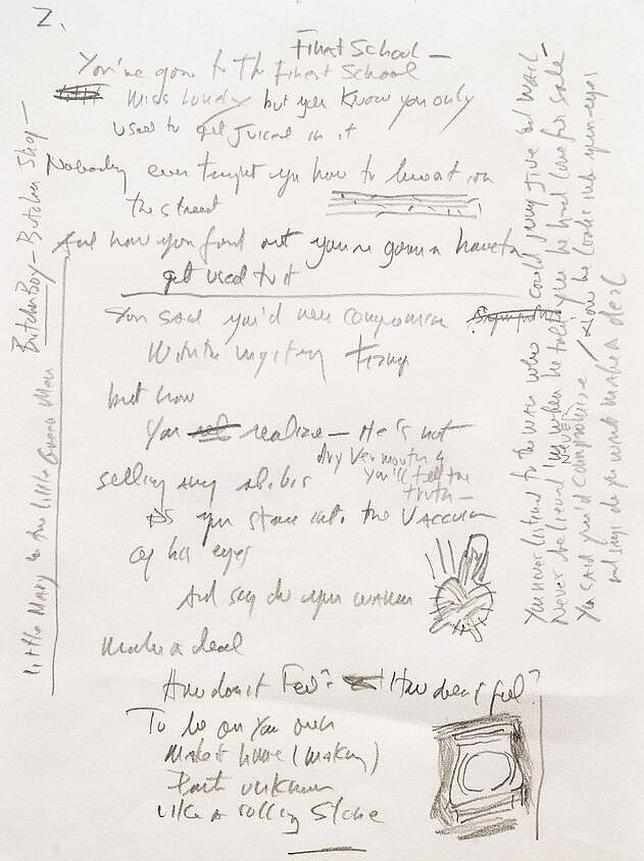When we are singing a song, although we are not fully aware of it, we are interpreting a special text, an organization, a certain form that almost always consists of musical sections that are composed of verses.
We are going to see what those verses are like and what makes them different, for example, from those we can find in a poem.
What is a verse?
If we had to define in a simple sentence what a verse consists of, we could say that it is a group of words that, respecting a certain metric and rhythm, form a formal unit in a literary text. They can be found in poems, in song lyrics or in other contexts, but, very often, they will be related to others to create structural sections of the work in which they appear (verses, choruses,…) and will contribute both to express a message or content how to put together a certain sound development.
Verses, poems and songs
Well, as almost everyone knows or can deduce, song lyrics, poems and poetry are very closely related. The word poetry, we leave it aside in these lines, because there are so many things that can make the word “poetry” come to mind, right?
 A title and four verses in English So, poems and lyrics. Both contain those lines that follow one another and often end where we expected them to. Longer or shorter, with or without rhyme, but in the vast majority of songs we will see that the lyrics have been written with those verses in mind, their length and rhythm, until they find their final form. It is not a coincidence. Verses offer various benefits when writing literary works. Thanks to well-planned verses, we will be able to achieve, among other things, that our ideas are concretized without giving too many detours, that there is a certain musicality in the simple verbal content and that the audience can recognize, anticipate and memorize a work more easily. Not bad.
A title and four verses in English So, poems and lyrics. Both contain those lines that follow one another and often end where we expected them to. Longer or shorter, with or without rhyme, but in the vast majority of songs we will see that the lyrics have been written with those verses in mind, their length and rhythm, until they find their final form. It is not a coincidence. Verses offer various benefits when writing literary works. Thanks to well-planned verses, we will be able to achieve, among other things, that our ideas are concretized without giving too many detours, that there is a certain musicality in the simple verbal content and that the audience can recognize, anticipate and memorize a work more easily. Not bad.
the verses of the songs
Those verses, when they appear in a song, are somehow being part of something bigger and are not the absolute protagonists of the show, so to speak. Those linked words, that occasional metric and rhyme, aim to find a melody that completes them and gives them their definitive place in the complete show that we call «song». Without it, they can pass for a poem, more or less, for a text with a certain technical and aesthetic rigor, as literature, in short, but not as song lyrics. We need music to make it what it wanted, or didn’t want to be.
 Manuscript of Like a Rolling Stone, by Bob Dylan
Manuscript of Like a Rolling Stone, by Bob Dylan
the syllables
And to create meaningful verses, with art and musicality, we have to count syllables. Eye. Not words, syllables. That is the rhythmic unit of a verse and by extension, of a poem or song lyrics. A syllable, for those who don’t know, is a short and controlled exhalation, a sound that we hear between two interruptions in the exit of air from our mouth. Those syllables are the ones that we have to take into account to establish the measure of each verse, but there are still some details that we have to talk about.
Count syllables of verses
Let’s review. A verse contains several words and, those words, one or several syllables. Very well. But by counting the syllables of each word in a verse and adding them up, many times we will not be faithful to how we actually pronounce the phrases or verbal expressions. When a word ends in a vowel and the next one also begins with a vowel, many times we will link them in what is called a metric syllable.
 Three English words of one syllable each
Three English words of one syllable each
The metric syllable
So, the metric syllable is the unit that we will use to measure the verses, each one of them, and find out the metric and rhythmic relationships that can be established between them. To do it correctly, we first have to make some concepts clear:
open vowels: a, hey
closed vowels: iyu
unstressed and stressed vowels: Atonics are weak, that is, they are not accented, and tonics are strong, regardless of whether they have an accent or not.
Hiatus: When two consecutive vowels, in a word, are pronounced separately and make up different syllables. This happens when there are two open vowels, they are two equal vowels if there is an unstressed open vowel + stressed closed vowel, or stressed closed vowel + unstressed open vowel. For example: tra-ve-sí-a, cre-er, pa-ís, ca-í-da, te-a-tro, …
Diphthong: When two consecutive vowels, in a word, are pronounced together, as a single syllable. That is, when hiatus cases do not occur. For example: a-cuer-do, noise-do, a-bier-ta, tiempo-po,… When this applies to vowels of different words, we find concepts such as the sinalefa. This situation, the sinalefa, occurs when a word ends in a vowel and the following also, forming a single metric syllable, that is, they are counted as a single syllable. For example: Es-ta-boh-cha-da – la – suer-te >>> (8 syllables) Also, remember that words can be
trowelswhen the penultimate syllable is stressed, whether or not it has a written accent.sharpwhen the last syllable is the strong oneesdrújulas, when the antepenultimate syllable is the one that is stressed. That said, and taking the last strong syllable of the verse as a reference, we will generally follow some simple rules. Yes it is flat, does not vary the number of syllables:
A – lo – lar–go – del – ca-me-no >>> (8 metric syllables)Si es sharp, you add a syllable to count: In – the – center – of – cris-such >>> (7+1 = 8 metric syllables)If it is esdrújula, we subtract one syllable to total: Al – co-start-zo – de – la – fa-bu-la >>> (9-1 = 8 metric syllables)
 letters for syllables
letters for syllables
Metric licenses
In any case, you should not get too overwhelmed with all these questions. In most cases we must follow our intuition, our habits when speaking, common sense and, above all, our ears. I mean that we don’t have to be a counting machine, or a mathematician of language, or anything like that. We are creating literary texts, something that could be considered art, and the goals are neither formal perfection nor accuracy in calculation. This is demonstrated in practice, throughout history, with the so-called poetic licensewhich are exactly that, the freedom that authors have to skip the rules, so to speak, and force a syllabic pronunciation different from the usual one in the reading.
syneresis: happens when two vowels of a word that do not form a diphthong are joined in a metric syllable. For example: Coh – la – llu-via – sal-va-je >>> (8 syllables)
umlaut: umlaut occurs when two vowels that form
diphthong to give rise to two metric syllables.
For example: When-do – lle-gue-el – dí-a – se-ña-la-do >>> (11 syllables) I repeat. Writing respecting a certain metric is fine, it provides consistency, a predictability that makes us anticipate, recognize the pattern and almost want to sing it, but we should not be obsessed or slaves to that type of syllabic counting, to call it that.
 Blade waiting verses
Blade waiting verses
Conclusions
Count syllables in each line and count lines in each stanza, single lines and rhyming lines, lines, lines, lines. Although we can organize the lyrics of a song as a prose text, the truth is that using verses facilitates the appearance, rhythm and musicality of any lyrics. Forcing ourselves, as it were, to adhere to a meter and often a rhyme, or to limit the space we have to say what we want to say, even if it initially seems like a problem or an obstacle, it is actually a blessing, a whisper in our hearts. heard that tells us: «think again» or «you can say it better». This type of brake, of opportunity to rethink what we are writing, ends up provoking new ideas, unexpected turns and, in general, a greater awareness of what we are doing. Try writing lyrics to a song or make a new one if you’ve already written one. Try to realize these technical details and the effect of having balanced verses, designed to express yourself but also to be sung, to resonate with the notes of a melody. You will probably find a world of new possibilities, a fertile ground to carry out the purpose you have set for that particular song and, perhaps, not be so predictable or use linguistic or literary resources repeated a thousand times. One way or another, write, make your voice heard in this crazy world of noise and nonsense. #mailpoet_form_3 .mailpoet_form { } #mailpoet_form_3 .mailpoet_column_with_background { padding: 10px; } #mailpoet_form_3 .mailpoet_form_column:not(:first-child) { margin-left: 20px; } #mailpoet_form_3 .mailpoet_paragraph { line-height: 20px; margin-bottom: 20px; } #mailpoet_form_3 .mailpoet_segment_label, #mailpoet_form_3 .mailpoet_text_label, #mailpoet_form_3 .mailpoet_textarea_label, #mailpoet_form_3 .mailpoet_select_label, #mailpoet_form_3 .mailpoet_radio_label, #mailpoet_form_3 .mailpoet_checkbox_label, #mailpoet_form_3 .mailpoet_list_label, #mailpoet_form_3 .mailpoet_date_label { display: block; font-weight: normal; } #mailpoet_form_3 .mailpoet_text, #mailpoet_form_3 .mailpoet_textarea, #mailpoet_form_3 .mailpoet_select, #mailpoet_form_3 .mailpoet_date_month, #mailpoet_form_3 .mailpoet_date_day, #mailpoet_form_3 .mailpoet_date_year, #mailpoet_form_3 .mailpoet_date { display: block; } #mailpoet_form_3 .mailpoet_text, #mailpoet_form_3 .mailpoet_textarea { width: 200px; } #mailpoet_form_3 .mailpoet_checkbox { } #mailpoet_form_3 .mailpoet_submit { } #mailpoet_form_3 .mailpoet_divider { } #mailpoet_form_3 .mailpoet_message { } #mailpoet_form_3 .mailpoet_form_loading { width: 30px; text-align: center; line-height: normal; } #mailpoet_form_3 .mailpoet_form_loading > span { width: 5px; height: 5px; background-color: #5b5b5b; }#mailpoet_form_3{border: 1px solid #fcb900;border-radius: 40px;text-align: center;}#mailpoet_form_3 form.mailpoet_form {padding: 20px;}#mailpoet_form_3{width: 70%;}#mailpoet_form_3 .mailpoet_message {margin : 0; padding: 0 20px;}#mailpoet_form_3 .mailpoet_paragraph.last {margin-bottom: 0} @media (max-width: 500px) {#mailpoet_form_3 {background-image: none;}} @media (min-width: 500px) { #mailpoet_form_3 .last .mailpoet_paragraph:last-child {margin-bottom: 0}} @media (max-width: 500px) {#mailpoet_form_3 .mailpoet_form_column:last-child .mailpoet_paragraph:last-child {margin-bottom: 0}} Please leave this field emptyDo you write songs or would you like to?
Email * I have read and accept the Privacy Policy With the Guide «the journey of a song» gift Check your inbox or spam folder to confirm your subscription.

